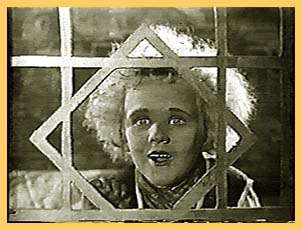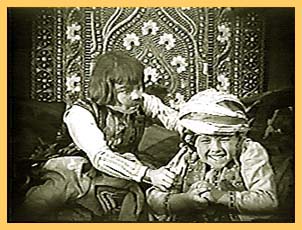

"Aladdin and His Wonderful Lamp" was the second in a series of Fox Kiddie Pictures released in 1917 and 1918 and directed by brothers C.M. and S.A. Franklin. The two had directed a series of children's shorts and features for D.W. Griffith which attracted the attention of William Fox. Fox told them he had an idea to make well-produced children's features with children in the lead roles and made the brothers an offer they couldn't refuse.
The series was a huge success and made stars of the children
who played in them - Francis Carpenter, Virginia Lee Corbin, Carmen
La Rue,  Violet Radcliffe,
Buddy Messinger, etc. Although Fox's publicity department no doubt
exaggerated the production costs of these films, it is obvious
they were produced with care and substantial budgets as the sets
and general production values are well above average.
Violet Radcliffe,
Buddy Messinger, etc. Although Fox's publicity department no doubt
exaggerated the production costs of these films, it is obvious
they were produced with care and substantial budgets as the sets
and general production values are well above average.
In "Aladdin," the viewer will see the stars decked in believable garb from the magical days of old Bagdad. Although the make-up is typical of the late 'teens (overdone), there are lots of extras, and the street scenes, especially, with the architecture of the structures is impressive. Gaudy, yet eye-catching, is the Sultan's palace, and the Princess' outfits are elaborate and would be appealing to youngsters at whom the picture was aimed.
A vintage newspaper review (source unknown) said, "The production is gorgeous. There are also many fine spectacular effects, wonderful Oriental atmosphere, colorful costumes and scenes of dashing horsemen on the desert.""(Unfortunately, the print reviewed shows no "dashing horsement on the desert.")
Speaking of sets, the cave Aladdin must enter to retrieve the lamp is actually accessed through a hole in the ground which is covered by a huge stone. Once inside, he descends a set of steps, walks through a long passageway that is very realistic-looking. He comes upon a pool of water, with beautiful plants and flowers around it, fed by a stream of water emanating from the mouth of a boar's (?) head on the wall. Two other boars' heads are on either side with fire billowing from their mouths. The magic lamp is in a recess in the wall with fire all around it. All pretty impressive stuff (no painted backgrounds here), and one only wonders what color would have done for this movie, especially in regards to the elaborate costumes.
 Overacted, But Still Delightful
Overacted, But Still DelightfulThe story line is the traditional Aladdin story, only done with children in the leads. Adults play all the peripheral roles, including the Sultan. All of the children overact, of course, but Violet Radcliffe deserves a little extra notice as she plays a male part, the evil magician al-Talib. Her mustache twirling and chin-rubbing are reminiscent of the Ford Sterling school of acting. Francis Carpenter shows anger many times by balling up his fist and swinging it from side to side while shoulders are hunched over and teeth are clenched. Virginia Lee Corbin is called upon to do what she does so well - cry on a moment's notice - yet, keep in mind, she is a talented little actress and makes the crying very convincing. It's delightful to watch her sigh and heave (literally!! - her little chest going up and down rapidly) over the charming Aladdin.
One vintage review said Carpenter and Corbin "do exceptional acting and acquit themselves with credit that many an older star would envy." Another said, "Virginia's playing of the lovesick princess with her bursts of temper and her coyness are said to be pure delight, while Francis with his shock of blond hair and his swagger is most effective."
Keep in mind the story was intended for children, and in that respect, it does very well. However, it can also hold the interest of adults, as well. Silent film historian Kevin Brownlow said, "The direction is so clever, so carefully balanced, that young children can take the adventure straight, with the thrills intact, and identify with the miniature cast, whereas adults and children old enough to appreciate the parody (of other popular films and stars of the day) can enjoy the picture on two levels."

As noted in the reviews of the time, Francis Carpenter and Virginia Lee Corbin are extremely charming in their roles. Carpenter had been making some films the previous year (he was only five years old at the time), and Corbin (who was six years old) was not entirely new to the screen when she began the Fox Kiddie Pictures, but her career prior to this appears to have consisted of a few three-reelers and some vaudeville. Carpenter went on to make 23 pictures with no credits after 1923. Obviously, Corbin enjoyed a greater success making 40 or more pictures in a career that lasted until the early 1930's. After outgrowing her children's roles, she had a short hiatus from the screen in the early twenties when she graced the vaudeville stage but returned by age 14 fitting very well into flapper roles of the 1920's.
Of the Fox Kiddie Pictures, it was believed that "Babes in the Woods" (1917), the third in the series, was the only one available for viewing (reportedly, "Jack and the Beanstalk" and "Ali Baba" exist out there somewhere, too), however, Jack Hardy of Grapevine Video brought "Aladdin" to video for collectors to enjoy, and he has provided us with a good print with a very acceptable organ score. At 40 minutes, however, the print is an abridgement of its original length. Articles from the period mention "dashing horsemen in the desert," "palaces appear in the waste place in the desert," and "a sandstorm that is one of the most realistic effects ever secured for a picture," yet none of these appear in the print reviewed here. Nevertheless, the story line flows smoothly and logically, and the viewer, if he had not already been told, would not realize there are missing scenes.
copyright 2001 by Tim Lussier, all rights reserved